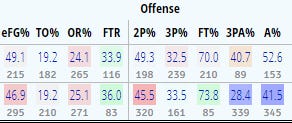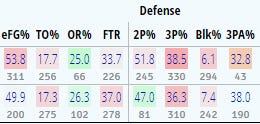Mark Fox, Year 2: What changed, what stayed the same?
A statistical look at the 2020-21 season, before we look back and look ahead
In Sunday morning’s recap of the Oregon game, I wrote this:
I’ll save the bulk of my thoughts for a longer, more detailed article once the season is 100% complete. There are a bunch of questions that I’ll be pondering between now and then. Among them:
Why did Cal not improve this year (and in fact probably got worse), when the Bears added two veteran grad transfers to an established core of returning players?
What chain of events led to these last four years of pain after a decade of success?
Considering those events, are there any prospects for improvement in the near future?
What does athletic department leadership want out of the MBB program?
Those are some questions that might take up a lot of space, and so I’m going to immediately go back on what I said earlier and try to start answering that first question. I’ll start by taking a detailed look at the results of the 2021 season, where Cal improved, where Cal got worse, and why.
Spoiler alert: Cal’s 2020-21 was mostly very, very similar to 2019-20, with a couple of key changes worth exploring.
Offense
First, here are Cal’s tempo-free stats from each of the last two seasons under Mark Fox:
2020-21 on top, 2019-20 on the bottom
On the left, you have the four factors. On the right, various component and style measures. What’s interesting is that while Cal’s style factors changed, in some cases dramatically, the results largely stayed the same. Cal’s turnover rate, offensive rebound rate, and free throw rate were virtually identical. The only thing that changed appreciably was Cal’s shooting, which went from abominable to . . . well, less bad*.
But that’s an important improvement. Shooting is the most important of the four factors, after all. What changed?
Despite bringing in more shooters, Cal’s 3 point shooting percentage actually declined by 1% this season. While that’s far from ideal, Cal’s shooting efficiency still improved significantly. How? Well, Cal’s two point shooting improved markedly. Some of that is down to individual improvement (Andre Kelly and Matt Bradley both improved their interior finishing as juniors) and better shot selection as a team.
Cal replaced a whole bunch of inefficient long 2s with comparatively efficient 3s. Per Torvik shooting splits, ‘long twos’ made up 35% of Cal’s offense last year, while this year they only made up 29% of Cal’s offense. So while 32.5% from deep isn’t exactly lighting the nets on fire, it’s better to shoot 32% from 3 than it is to shoot, say, 36% on a two point jumper.
Quick summary: Cal’s offense was virtually identical, except with a meaningful improvement in shot selection and shot finishing, which led to across the board more efficient field goal shooting.
*For those curious, Cal’s decline in FT shooting percentage is almost entirely down to losing Paris Austin, who shot 84 from the line on a pretty high volume.
Defense
Again: Cal’s tempo-free stats from each of the last two seasons under Mark Fox:
2020-21 on top, 2019-20 on the bottom
Again, year over year Cal’s stats are pretty steady. If you squint, maybe Cal got a touch better at securing defensive rebounds and defending without fouling, but for the most part this is a very similar chart, except for one huge glaring problem:
Cal can’t make anybody miss a shot.
And really, this is the story (and mystery) of the 2020-21 season. In Year 1, Mark Fox took a group of players that had been taught virtually nothing about how to play defense at the college level, and in one year he made it much more difficult to get easy baskets. Sure, teams were still raining 3s on the Bears, but Cal was no longer allowing layup lines. That 47% allowed on 2 point shots in 19-20, good for 81st in the nation, felt like a harbinger of the kind of defenses Fox has built at every stop in his career.
So why, in year two, did Cal’s defense regress so badly?
I’ve seen a few different theories floating around. One explanation is that Paris Austin and Kareem South were simply better perimeter defenders than Ryan Betley and Makale Foreman. Paris Austin in particular stood out for his defensive improvement last year, so I find this explanation reasonably plausible. Another explanation is that the combination of pre-season COVID-related disruption and in-season injuries to Matt Bradley and Grant Anticevich fatally damaged any chance of stability and team development. Again, this is plausible but less satisfying, as I don’t get the sense that Cal’s COVID-related disruptions were more significant than what other teams tended to face. And while missing Bradley and Anticevich certainly hurt in the moment, it’s not like Cal’s defense has played significantly better over the last couple of weeks with the whole rotation available.
Regardless of the precise explanation, this is the single thing Cal most needs to improve upon. Cal did lots of little things to improve on the margins from what was generally considered a successful year 1 - improved shot selection, slightly better rebounding, skill improvement from a few returning players. But whatever those improvements were worth, they were more than given away by team defense. We can only hope that a normal off-season will allow Mark Fox to get back to playing the kind of defense that kept his Georgia teams competitive in the SEC.






Nobody is thrilled with the way things are going, but lost in all of this is the Wyking talent drain. Justice is currently starting and one of the leading scorers for a top 5-10 OSU team; Vanover is a key contributor on a borderline top 10 team at Arkansas; and McNeil is a key contributor on what seems to be a pretty good SMU team. They would be 3 of our 4 best players right now, and the recruiting the last two years has been nowhere close to being at the level to replace any one of those guys, much less all 3 of them. Against that backdrop, I think that the injuries and other time missed by guys like Bradley and Grant means more to this team than it does other programs.
Looks like there is maybe/sorta a bit of an uptick this year in recruiting? But unless we start re-stocking with legitimate power 5 caliber players, this isn't going to get meaningfully better no matter what else Fox does, though I don't think the apparent lack of improvement by any of the players here is a vote of confidence that recruiting is going to get significantly better anytime soon. And if we are pinning our hopes on the transfer portal, yikes. Maybe the late-game ball will bounce our way and we'll win a few more close games some season than we did this year and inch closer to a .500 conference record, but that seems like the ceiling here, and that seemed like it was the ceiling even when he was hired. There is no reasonable opportunity to move on, but maybe our next coaching search will include something resembling a real process instead of the AD simply going with a consultant's recommendation.
Maybe it’s faulty memory, but the Berkeley disruption to preseason practice seemed way more than schools in other geographies experienced. The teammates had to be outside and couldn’t even touch the same ball all summer. If defense takes more practice to get right, I am unsurprised at the result and chalk up this season as doomed from the start because of Berkeley’s health restrictions.